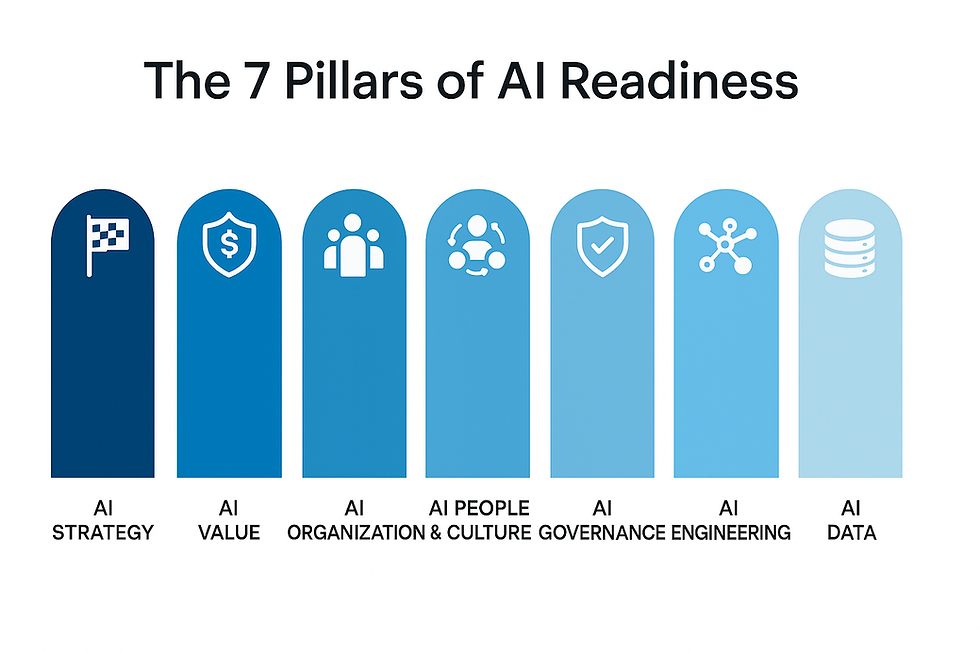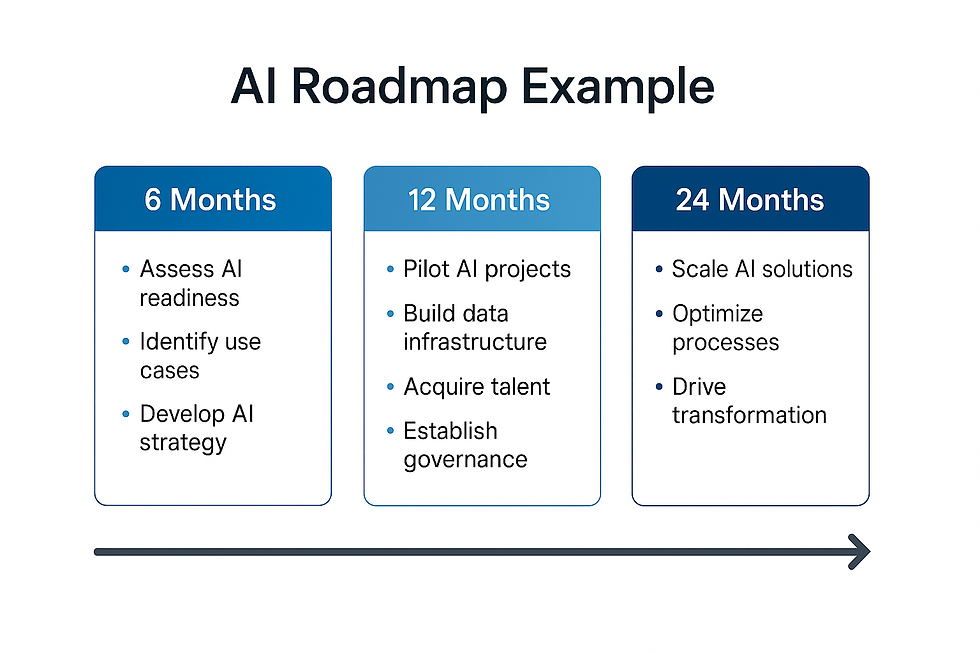The AI Readiness Playbook: How to Assess, Plan, and Implement AI in Your Business
- William Beresford
- Aug 8
- 5 min read
Artificial intelligence is no longer a futuristic experiment — it’s a boardroom priority. From customer service automation to supply chain optimisation, AI is transforming how organisations operate, compete, and grow.
But there’s a catch. Too many companies rush into building AI models before laying the foundations for success. The result? Costly pilots that never scale, fragmented initiatives that don’t connect to strategy, and disillusioned leaders who question the value of AI altogether.
This is where AI readiness comes in at Beyond, we’ve learned that the difference between AI hype and AI impact lies in preparation - building the strategy, capabilities, governance, and culture to deliver sustainable value at scale. This playbook will guide you through assessing your readiness, planning a roadmap, and implementing AI in a way that sticks.
Why AI Readiness Matters in 2025
The pace of AI innovation is really staggering. Generative AI, multimodal models, and agent-based automation are opening new possibilities — but they also create new complexities.
Organisations that are ready to adopt AI successfully share common traits:
They link AI directly to business strategy.
They sequence capability building alongside high-impact use cases.
They balance innovation with governance, ensuring risks are managed from day one.
They embed AI into operating models, rather than treating it as a side project.
In other words, they’ve prepared for AI not just technically, but strategically, organisationally, and culturally.
The 7 Pillars of AI Readiness
Based on industry-leading frameworks and our work with clients across multiple sectors, we see AI readiness as seven interconnected pillars:

1. AI Strategy
A clear, documented AI ambition that’s fully aligned with your business goals. This means:
Defining the role AI will play in achieving your strategic priorities.
Setting measurable success criteria.
Continuously realigning as markets, technology, and regulation change.
2. AI Value
Focusing AI investments on use cases with tangible business impact — and proving it.Start with a prioritised list of opportunities, run proof-of-value projects, and scale the winners. Implement ongoing measurement so AI continues to deliver ROI long after launch.
3. AI Organization
Structuring your teams, roles, and decision rights for scale. This includes:
Dedicated AI leadership.
Communities of practice and centres of excellence.
Clear accountability for delivery and value realisation.
4. AI People & Culture
AI adoption is as much about people as it is about technology. Success requires:
Building AI literacy across the workforce.
Creating change champions in every business area.
Designing new ways of working to blend human judgment with machine intelligence.
5. AI Governance
Managing risk, ethics, and compliance from the outset. Strong AI governance frameworks define:
Principles and policies for responsible AI.
Decision-making structures.
Processes for monitoring and addressing bias, explainability, and compliance.
6. AI Engineering
The technical foundation for scaling AI. This means:
Standardised development workflows.
ModelOps and automation for deployment.
Scalable infrastructure that supports experimentation and production.
7. AI Data
Data that’s not just accurate, but AI-ready. Key capabilities include:
Data quality, observability, and governance tailored for AI workloads.
Metadata and lineage tracking.
Architecture that supports the scale, speed, and complexity of AI use cases.
Step 1: Assess Your AI Readiness
Before building an AI roadmap, you need a clear, honest picture of where you stand in each pillar.A robust readiness assessment should cover:
Strategic clarity: Is there a shared AI ambition across leadership?
Value alignment: Do we have a prioritised set of use cases with measurable benefits?
Organisational capacity: Are roles, responsibilities, and structures in place?
Cultural preparedness: Are employees engaged, informed, and supportive?
Governance maturity: Are risks, ethics, and compliance processes in place?
Technical capability: Can we reliably develop, deploy, and maintain AI solutions?
Data fitness: Is our data prepared for AI’s scale and complexity?
From our experience, the most common readiness gaps are:
Weak connection between AI initiatives and core business KPIs.
Governance frameworks developed too late in the process.
Data suitable for business intelligence but not optimised for AI models.
Talent and skills spread thinly without a unifying operating model.
Step 2: Plan Your AI Roadmap
A roadmap turns assessment into action. The goal is to sequence capability building and value delivery together.

Key principles for an effective AI roadmap:
Menu, not mandate: Choose the activities that make sense for your goals and maturity level.
Early wins: Select initial use cases that can prove value quickly.
Parallel capability building: Develop governance, engineering, and data foundations alongside use case delivery.
Horizon planning: Map activities over 6, 12, and 24 months to maintain momentum without overloading teams.
Step 3: Implement for Sustainable Value
The transition from pilot to production is where many AI projects stall. To avoid “AI tourism” — short-lived experiments that never deliver — you need a disciplined implementation process:
Proof of Value (PoV) – Small-scale tests to confirm business impact.
Pilot – Controlled deployment with real users.
Scale – Full rollout with supporting infrastructure, governance, and training.
Crucially, scaling AI means embedding value measurement into ongoing operations. Business conditions change, customer behaviours shift, and models drift — monitoring and iteration are non-negotiable.
What This Looks Like in Practice
While every organisation’s journey is unique, in our experience we see some common patterns emerging as illustrated by these three examples from Beyonds clients:
A national retailer who started with fragmented analytics invested in governance, data quality, and role clarity before launching personalised customer engagement at scale.
A hospitality group built AI literacy across its operational teams before automating guest experience workflows, ensuring adoption rather than resistance.
A B2B service provider restructured its data and engineering teams under a unified AI operating model, unlocking faster delivery and greater cross-functional value.
In each case, readiness work created the conditions for AI to deliver sustained impact.
Beyond’s AI Readiness Framework
At Beyond, we guide organisations through the entire readiness journey:
Diagnostics to assess strengths and gaps across the 7 pillars.
Roadmap design that sequences quick wins and long-term capabilities.
Implementation support blending AI strategy, data architecture, engineering, and change management.
Ongoing optimisation to ensure AI delivers value in changing market conditions.
Our philosophy is simple: AI success comes from alignment, integration, and sustainability - not from chasing the latest trend.
Conclusion: Readiness Is the Real Competitive Advantage
In 2025, AI leadership won’t be defined by who adopts technology first, but by who adopts it best. Readiness isn’t a delay tactic - it’s the foundation for faster, safer, and more profitable AI deployment.
If your organisation is ready to move from AI ambition to AI impact, start by assessing your readiness, building your roadmap, and embedding the capabilities that make AI stick.
→ Take the first step with an AI Readiness Diagnostic and discover where you stand today. Contact us.




Comments